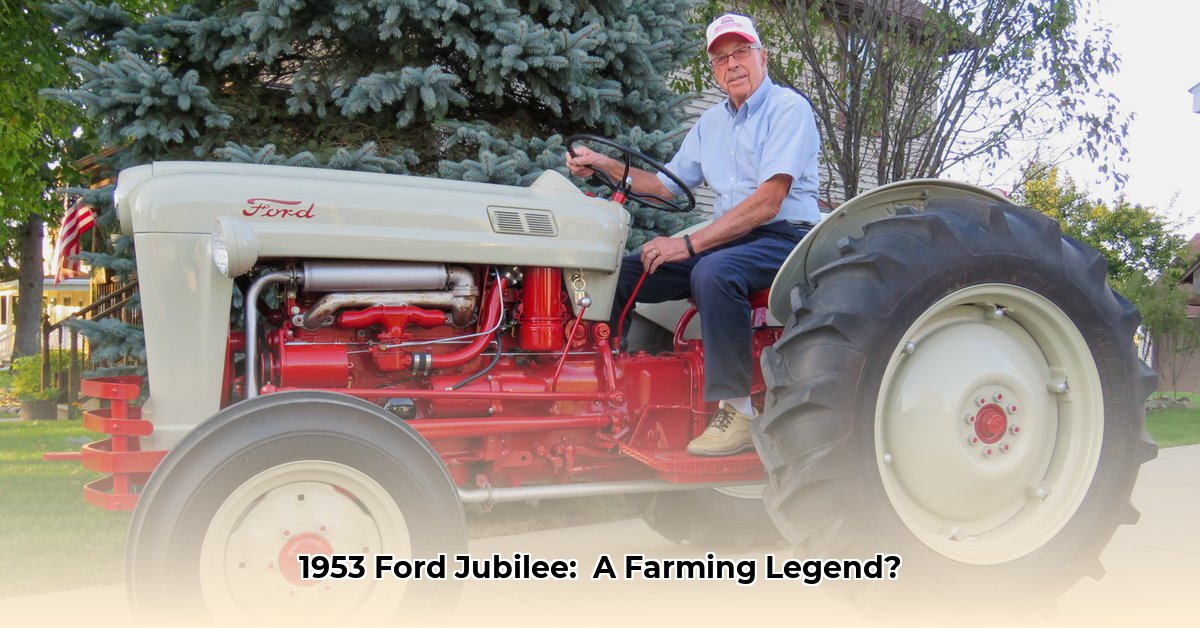
The 1953 Ford Jubilee tractor, also known as the Ford NAA, represents a pivotal moment in agricultural history. This iconic machine, instantly recognizable by its golden hue, revolutionized farming practices in the post-war era, offering a powerful yet relatively affordable solution for expanding farms. This article delves into its historical context, technical specifications, and enduring relevance, even within the framework of modern sustainable agriculture. For more on vintage tractors, see this site.
The Ford Jubilee: A Post-War Powerhouse
The post-World War II agricultural landscape demanded increased efficiency. Farmers needed machinery that could handle larger fields and heavier workloads. The Ford Jubilee answered this call, providing a significant upgrade over older, less-powerful tractors. Its innovative features, coupled with its relatively accessible price point, quickly made it a favorite among farmers. But what exactly made the Jubilee so impactful?
Technical Specifications and Innovations
Powering the Jubilee was a four-cylinder gasoline engine, boasting 120 cubic inches of displacement. While reported horsepower varies (sources cite figures between 20 and 30 hp), this discrepancy likely stems from differing testing methodologies and the inevitable wear and tear on individual tractors over the decades. Think of it like classic car horsepower ratings – variations are common.
The transmission was a straightforward four-speed manual, a design that prioritized simplicity and ease of use. However, this simplicity was far from a drawback. Features like the three-point hitch and power takeoff (PTO) were game-changers. The three-point hitch simplified the process of attaching implements, and the PTO provided power to these implements, boosting efficiency exponentially. The tractor's pulling power was substantial, capable of handling three 14-inch plows or two 16-inch plows—a significant feat for its time.
Here’s a summary of its key specifications:
| Specification | Details |
|---|---|
| Engine | Four-cylinder, 120 cubic inch gasoline engine |
| Horsepower (Claimed) | 20-30 hp (varied depending on source and condition) |
| Transmission | Four-speed manual |
| Fuel Tank Capacity | Approximately 11 gallons |
| Notable Features | Three-point hitch, power takeoff (PTO) |
These features weren't just innovative for 1953; they foreshadowed many advancements in agricultural technology. The Jubilee served as a bridge between the past and the future of farming.
The Ford Jubilee and Sustainable Farming: A Retrospective
How does the Ford Jubilee compare to modern sustainable farming practices? Compared to present-day tractors, its horsepower was modest, resulting in slower task completion times. Its smaller fuel tank necessitated more frequent refueling, adding operational costs. Furthermore, it lacked the advanced fuel efficiency monitoring and sophisticated control systems now considered essential. GPS guidance and precision seeding were, of course, absent.
However, it's crucial to view the Jubilee within its historical context. It represented a massive step forward from horse-drawn plows, dramatically boosting productivity and efficiency for its era. The enduring popularity and collectible value of these tractors underscore their robust construction and lasting impact.
Beyond the Field: Collector's Item and Historical Significance
Restored Ford Jubilee tractors fetch impressive prices at auctions today. This high value isn't solely about the machine’s functionality; it reflects its place in agricultural history. Restoring these tractors isn't merely a hobby; it's a preservation of heritage, a connection to past agricultural practices, and a testament to the ingenuity of previous generations. These tractors serve as living artifacts, keeping the history and evolution of farming alive.
Fuel Efficiency: Then and Now
Comparing the fuel efficiency of vintage tractors like the Ford Jubilee to modern, sustainable tractors presents a complex challenge. It's not solely about gallons per hour; it's about the work accomplished per unit of fuel consumed. A modern tractor may use less fuel per hour, but it also accomplishes vastly more work in that time. Therefore, a more appropriate comparison would examine fuel consumption per acre worked or per ton of crop harvested.
The Ford Jubilee, with its simpler engine and lack of advanced fuel-saving technology, had relatively high fuel consumption in comparison to modern-day counterparts. Modern sustainable tractors leverage technologies like Tier 4 Final engines (meeting strict emission standards), electronic control systems (optimizing fuel delivery), and auto-guidance systems (preventing overlap and maximizing fuel efficiency). While these advanced systems improve efficiency, their initial costs are significantly higher.
Retrofitting vintage tractors with newer technologies like improved fuel filters might offer some sustainability improvements, but the feasibility and cost-effectiveness must be carefully considered.
Key Takeaways:
- The Ford Jubilee, while revolutionary for its time, lacked the advanced fuel efficiency of modern tractors.
- Modern sustainable farming tractors prioritize fuel efficiency through technological advancements and precision farming techniques, resulting in better fuel economy per unit of work.
- Direct fuel consumption comparisons between the Jubilee and modern tractors require careful accounting of work output, not just fuel consumption rates.
The 1953 Ford Jubilee tractor stands as a symbol of agricultural progress. Its legacy extends beyond its era, prompting reflections on the ongoing evolution of farming practices and the importance of preserving agricultural history. The tractor’s story underscores the crucial interplay between technological innovation and sustainable agricultural practices, and showcases the continuous journey towards more efficient and environmentally responsible farming methods.